
The cost of industrial meat: displacement, conflict and environmental destruction
by GRAIN | Oct 16, 2024
The rapid expansion of mega-farms in Latin America is leading to severe socio-environmental conflict. This industrial model of meat production is pushing out traditional food systems and taking over Indigenous and peasant territories, where it is devastating biodiversity, polluting ecosystems and degrading soil. It is also exacerbating public health issues and land conflicts, fuelling a vicious circle of inequality and violence.
Since 2017, the Indigenous Mayan community of Homún, in Yucatán, Mexico, has opposed a mega pig farm on their territory, established without free, prior and informed consent – a right guaranteed by ILO Convention 169, ratified by Mexico in 1990. The farm, owned by Producción Alimentaria Porcícola (PAPO), a subsidiary of Kekén, one of the largest pork producers in Yucatán[1], sparked concerns about its impact on the environment, biodiversity and local livelihoods. Swine waste and other pollutants were seeping into the porous subsoil, polluting the cenotes, wells that are sacred in Mayan culture and are vital sources of water for the community[2].
Those defending the cenotes in Homún have faced threats for demanding that the farm be shut down[3]. However, in February 2024, a federal court issued a landmark ruling that revoked its environmental permit and ordered the closure of the facility, after reports by experts revealed environmental and violations[4].
The case illustrates the resistance of the Mayan people in defending their territories and rights against the expansion of the polluting meat agro-industry, a struggle that has also been faced by other communities opposing these mega-farms, such as the Sitilpech, Chapab, Kinchil, San Fernando and Celestún communities[5].
The meat industry in Latin America are mainly focused on the mass production of pork, chicken, beef, shrimp and salmon, driving the expansion of mega-farms. This expansion has caused severe conflicts and pollution in peasant and Indigenous territories, where local communities are suffering the serious environmental and social consequences[6].<
Governments in the region have tended to support this expansion through policies and regulations that benefit factory farming, while making it more difficult for traditional farming systems to survive. Health and safety regulations are designed in such a way that only major corporations can comply with them, excluding small producers and limiting their access to the market[7].
As such, the peasant and Indigenous communities denouncing the negative impact of these operations face threats, displacement, criminalisation and violence from corporations[8]. Factory farming is geared towards maximising production and economic gain at all costs, be they social, environmental or in terms of animal welfare.
These corporations subject animals to extreme overcrowding, which constitutes cruel treatment and generates a huge amount of waste and pollution. Not only does this situation seriously impact the health and food sovereignty of neighbouring communities, but it also endangers fragile ecosystems. Nevertheless, many communities in Latin America are putting up an active resistance, fighting to expel these harmful operations from their territories and defending their right to a healthy environment and a decent life.
|
Company
|
Country
|
Key investors
|
|
JBS
|
Brazil
|
BNDES Participações S.A.
REAG Gestora de Recursos Ltda.
Capital Research & Management Co.
BB Gestão de Recursos DTVM S.A.
|
|
BRF
|
Brazil
|
Polunin Capital Partners Ltd.
Macquarie Group Limited
The Goldman Sachs Group, Inc.
Renaissance Technologies LLC
BlackRock, Inc.
|
|
Tyson Foods
|
United States
|
The Vanguard Group, Inc.
BlackRock, Inc.
T. Rowe Price Associates, Inc.
State Street Corporation
Wellington Management Group LLP
|
|
Smithfield Foods
|
China
|
WH Group
|
|
Minerva SA
|
Brazil
|
Saudi Agricultural & Livestock Investment Company (SALIC)
Vilela de Queiroz Family
T. Rowe Price Associates, Inc.
Compass Group LLC
|
|
Hormel Foods Corporation
|
United States
|
The Vanguard Group, Inc.
BlackRock, Inc.
State Street Corporation
Geode Capital Management, LLC
|
|
CONAGRA
|
United States
|
The Vanguard Group, Inc.
BlackRock, Inc
T. Rowe Price Associates, Inc.
State Street Corporation
American Century Companies, Inc.
|
Global meat production
In the last two decades, meat production and consumption have increased by 53% worldwide, with chicken, pork and beef accounting for almost 90% of the total[9]. These animals are mainly reared on industrial farms run by large corporations, which has led to a high concentration of the meat production, processing and marketing sectors. A small group of companies controls a large share of the market. This raises concerns about sustainability, animal welfare and the environmental and social impact of these industrial methods, especially in highly biodiverse regions where the expansion of meat-producing industries is threatening local ecosystems.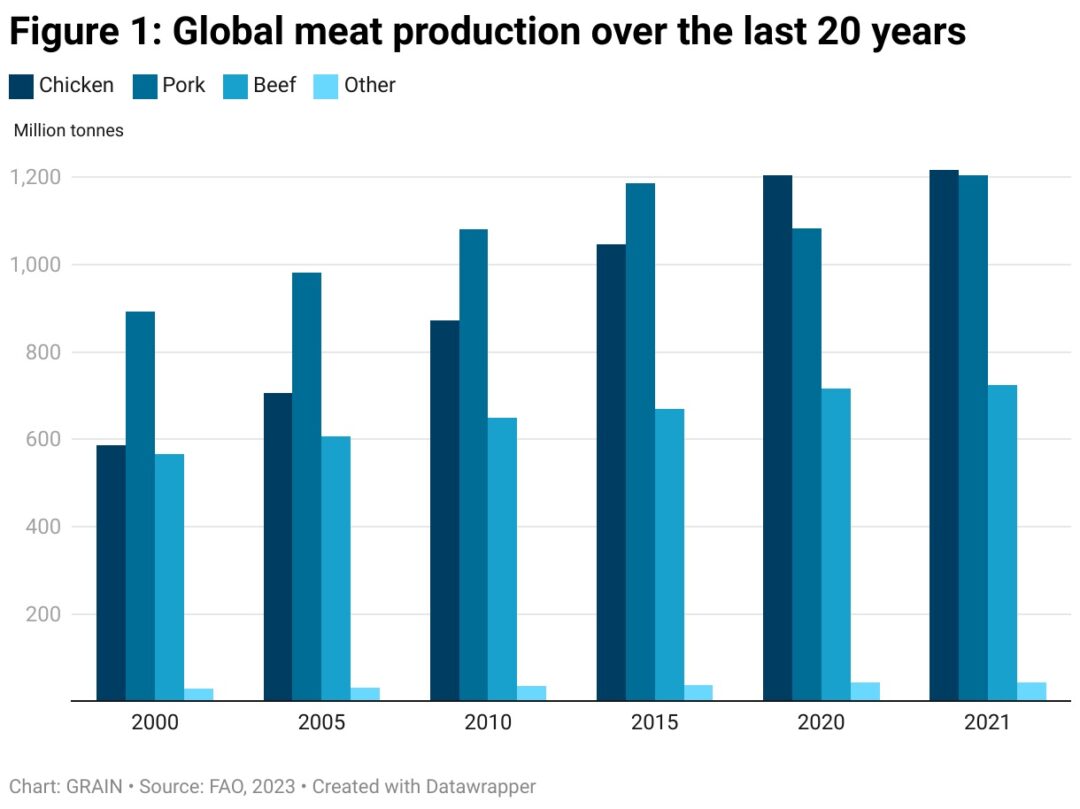
[10]
Industrial meat production is heavily concentrated in a handful of countries. For example, China, Brazil and the United States produce about 42% of the world’s chicken, while China, the United States and Spain control around 60% of global pork production. Beef production follows a similar pattern, with China, the United States and Brazil accounting for approximately 40% of the world total[11].
Transnational meat-producing corporations have taken advantage of neoliberal globalisation to move their operations to poorer countries, where production costs are significantly lower, thus maximising their profit margins. One example is Smithfield Foods, the world’s largest pork producer, owned by the Chinese conglomerate WH Group, which has established farms in Mexico and Eastern Europe in order to cut costs. Similarly, Tyson Foods, a leader in the poultry industry, has expanded its chicken production in China and increased its presence in India, Argentina and Brazil, capitalising on weaker labour standards and lower production costs in these regions[12].
The profitability of these corporations is also underpinned by subsidies and protectionist measures implemented by governments in the Global North. Through multi-million-dollar subsidies, countries such as the United States, Canada, New Zealand, Spain and Denmark are able to maintain artificially low prices on the world market, skewing competition and benefiting big business. Not only do these subsidies encourage the overproduction of meat, but they are also displacing small, local producers in many regions of the Global South[13].
A significant portion of this industry depends on the exploitation of migrant workers, primarily from the Global South, who face precarious working conditions in meat processing plants across the US and Europe. This production model fuels a vicious circle of exploitation, whereby the most vulnerable workers bear the brunt of the harshest conditions while corporations amass huge profits.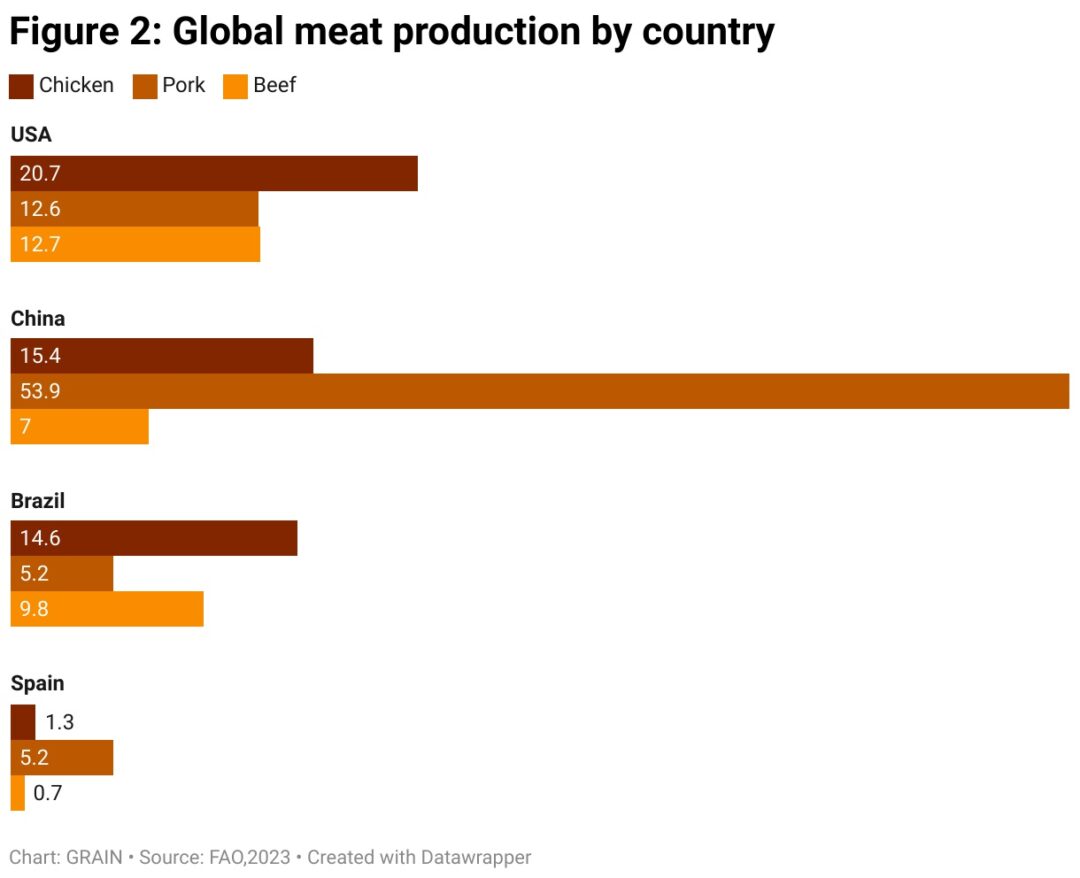
[14]
Additionally, Latin America has seen a significant expansion in factory farming, driven mainly by the increase in global demand, especially in countries such as China. Within this context, new meat-producing corporations from the Global South have become key players in the industry. A prime example is Brazil-based JBS, which is now ranked the world’s largest meat producer[15].
This growth has led multinationals to expand their operations in the region, taking advantage of the abundant natural resources and low production costs.
This phenomenon reflects the region’s growing role in global food production chains, with significant socio-economic and ecological consequences.
Another company of note is BRF, also Brazilian, which has positioned itself as one of the world’s largest intensive pig and poultry producers. These companies have adopted international expansion strategies to become transnationals, competing with their Northern counterparts with the backing of government subsidies, investment funds and loans from public development banks.
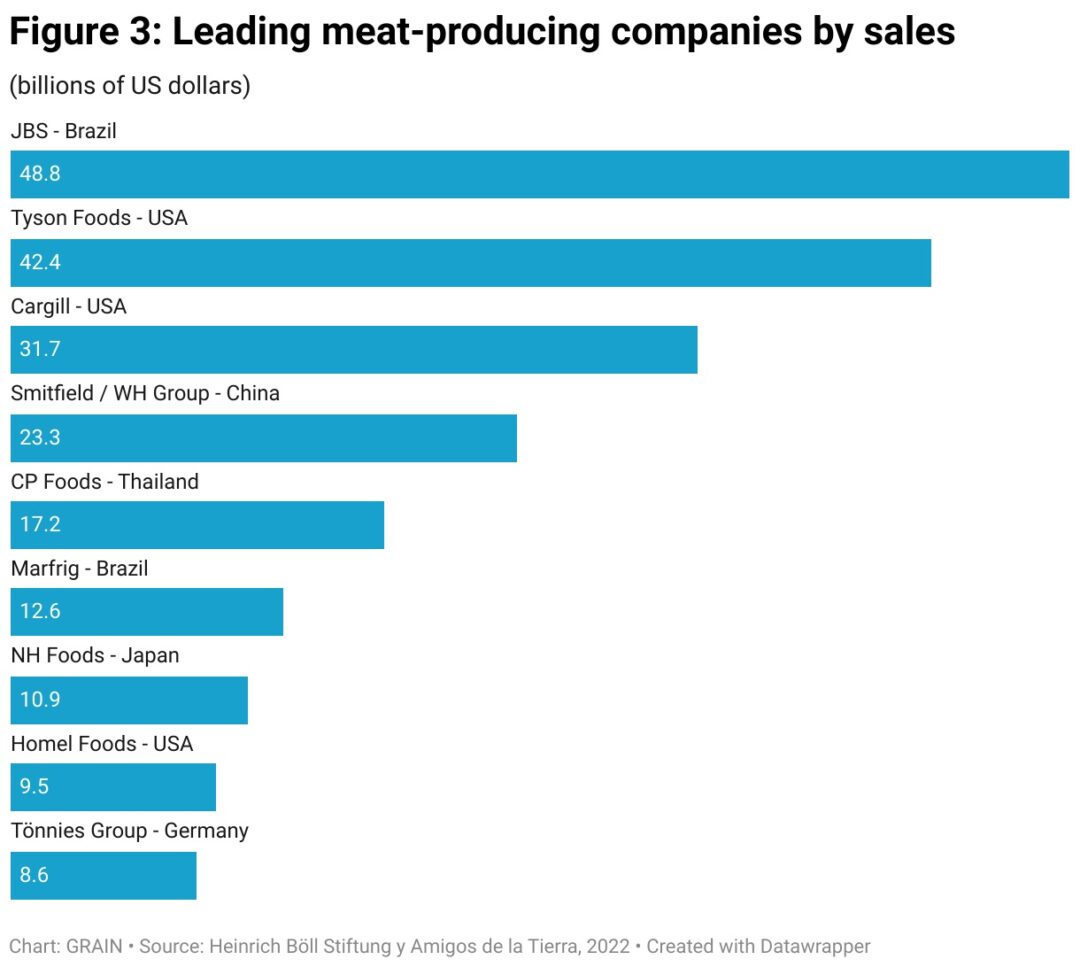
[16]
In parallel, global aquaculture production has tripled in the last two decades due to the intensification of farming systems, especially for species such as salmon, shrimp and tilapia. This has been made possible by the use of processed feed to accelerate growth, along with antibiotics and chemicals to control disease. However, these environmental methods have raised serious public health concerns, such as antimicrobial resistance, the contamination of aquatic ecosystems and eutrophication caused by organic waste and uneaten food[17].
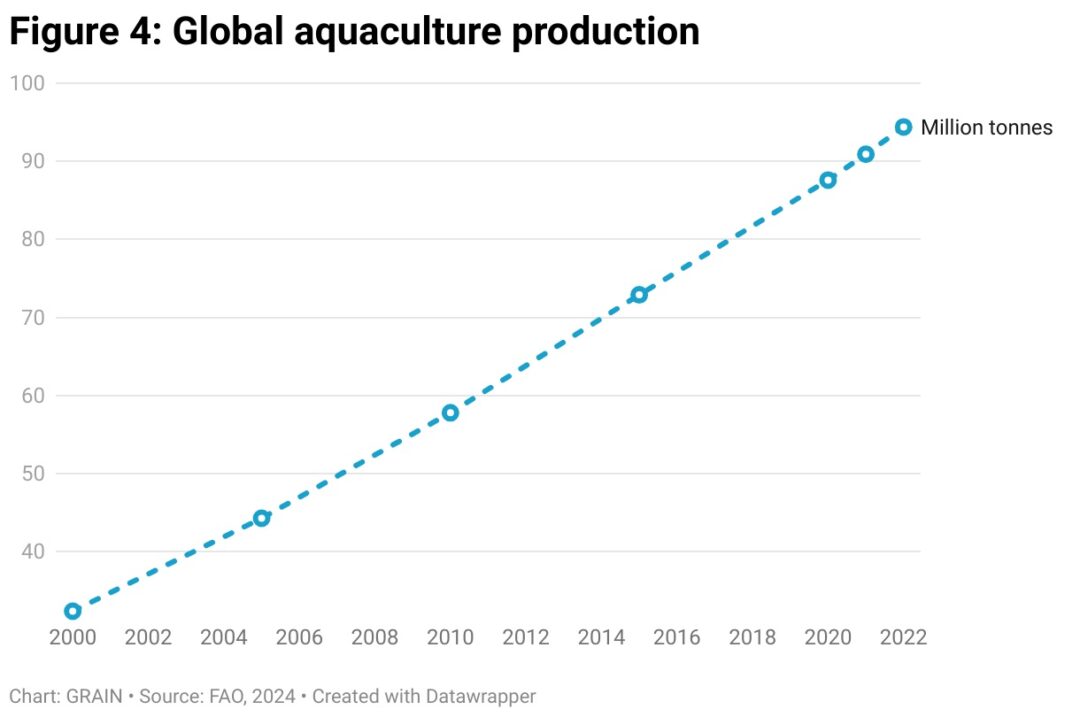
[18]
In Latin America, the industrial production of aquatic species is concentrated in Chile, Ecuador and Brazil, making the region the second largest producer in the world, behind Asia. This expansion has also sparked controversy over its social and environmental consequences, especially for local communities whose traditional livelihoods have been disrupted.
The salmon farming industry in Chile, for example, has been singled out for its serious environmental impact, mainly due to water pollution caused by the excessive use of chemicals and antibiotics, as well as the dumping of millions of dead salmon into the sea[19]. These practices have directly affected thousands of small-scale fishermen, who have seen their fishing opportunities restricted in areas close to fish farms. In addition to ecological problems, the industry has been accused of misinformation and illegally acquiring marine territories belonging to Indigenous communities, which has led to serious conflicts with those whose livelihoods depend on fishing and farming[20].
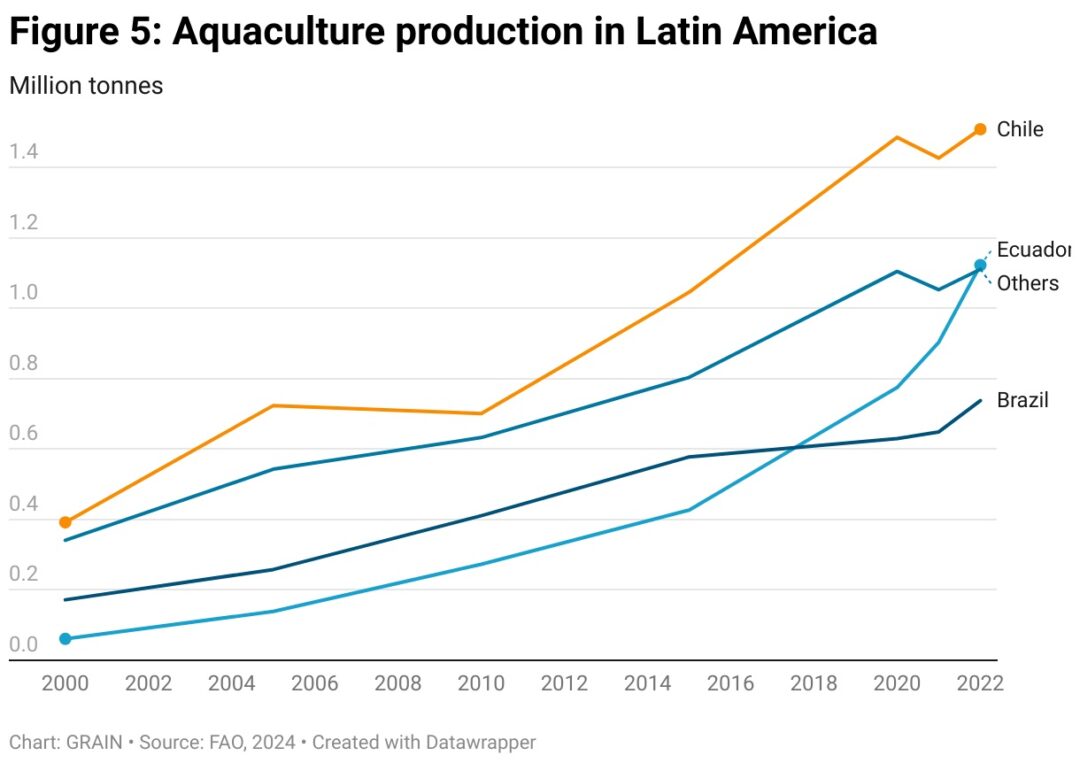
[21]
In Ecuador, the shrimp industry has destroyed approximately 70% of the country’s mangroves[22] -vital ecosystems that support biodiversity, serve as breeding grounds for aquatic species, act as natural storm barriers and help reduce coastal erosion. The shift of these mangroves into shrimp farms has wiped out these habitats, disrupting sedimentation and water flow patterns essential for their regeneration. This is severely impacting the food supply for approximately 100,000 families who depend on artisanal fishing, as well as shellfish and crab harvesting. Additionally, water pollution from chemical and organic waste produced by shrimp farms has worsened the damage, harming aquatic ecosystems and further weakening the mangrove’s biodiversity. As a result, key ecosystem services such as carbon sequestration are compromised, exacerbating the effects of climate change in the region.
Recently, the expansion of aquaculture in highland areas has led to soil and aquifer salinisation, reducing the agricultural capacity of the Ecuadorian coast[23]. Thousands of peasant families are losing their land and facing limited access to fresh water, aggravating food insecurity and increasing pressure on water resources in rural areas.
The health and environmental impacts of factory farming on peasant and Indigenous populations
Factory farming has had a significant impact on human health, mainly due to the high density of animals held in confined spaces, which promotes the spread of zoonotic diseases. This practice increases the risk of disease outbreaks, as viruses can mutate and jump from animals to humans.
Notable examples include viruses emerging from industrially farmed animals that then infect people. Diseases such as bird flu (H5N1) and swine influenza (H1N1), both suspected of originating in mega-farms, have killed millions of birds and pigs, as well as thousands of people. In the 2009 outbreak of swine flu in La Gloria, Mexico, the intensive pig farming facility Granjas Carroll was identified as the potential source of the epidemic[24].
In the last major outbreak of bird flu in Latin America, more than half of the cases were traced back to factory farms[25], where the risk of transmission to humans is highest. This poses a particular threat to farm workers, who are in constant contact with animals and their waste, exposing them to a higher risk of infection.
In Brazil, the transnational BRF, one of the world’s largest industrial pig and poultry farming companies, has recently been involved in multiple corruption scandals, including the falsification of laboratory results to cover up salmonella contamination in batches of meat[26]. This illustrates how these companies can prioritise profit over public health risks.
Another major health concern is the widespread use of antibiotics in factory farming, as mentioned above. In Chile, the salmon industry uses 3,600 times more antibiotics than are used for human health[27], which could contribute to the rise of antibiotic resistance among local communities and consumers.
The pollution generated by these farms is contaminating drainage basins, soil and air. This has been denounced in several countries, especially Ecuador, Mexico, Brazil and Argentina.
The dominance of a few large corporations in Latin America’s meat sector limits competition for farmers and peasants, forcing them to contend with the artificially low prices set by these companies. In parallel, the costs force these peasant farmers continue to rise, while government support remains minimal.<
All this comes against a backdrop of rapidly increasing global meat consumption, with a rise of 76% forecast by 2050[28]. This trend has serious environmental consequences, as livestock is responsible for a significant proportion of global deforestation and about 12% of greenhouse gas emissions[29].<
While meat consumption remains highest in northern countries, it has seen significant growth in China, Brazil and India. This rise stems from the expanding urban population and increasing industrialisation in these countries, leading the growing middle classes in these countries to consume more meat.
Consequently, governments tend to be more lenient with regulations and offer greater support to industrial meat-producing corporations[30].
In southern countries, the increased consumption of meat, especially beef, is perceived as a form of access to “luxury goods” that reflects a lifestyle associated with northern nations. This creates a product targeted at a small number of social classes, who consume this meat without understanding of how it is produced or its impact on peasant and Indigenous communities.
Conflict, violence and intimidation caused by factory farming in Latin America
In Latin America, factory farming follows a global pattern whereby power lies in the hands of a small number of multinational corporations. The growing demand for meat products and their own quest for higher profits, is expanding the operations of these corporations in the region, taking advantage of flimsy regulations and the vulnerability of local communities. The environmental, social and economic consequences disproportionally affect peasant populations.
In the case of industrial pig and poultry farming, numerous conflicts are emerging in peasant and Indigenous territories. In Mexico, major corporations such as Kuo and Granjas Carroll (Smithfield Foods) have been accused of causing social and environmental harm[31]. These companies, with the complicity of the state, intimidate local communities, among them Homún, Yucatán, where authorities attempted to close down ecotourism cenotes belonging to Mayan families who opposed their operations, resulting in the criminalisation of some of their leaders[32], as mentioned at the beginning of this article.
In Ecuador, the Indigenous Tsáchila communities of Santo Domingo have been denouncing the contamination of their rivers by Pronaca[33], one of the country’s leading producers of pork and chicken, for over 20 years. The company, which originated in Ecuador and Guatemala, established its operations in Tsáchila territory without prior consultation[34], violating collective rights. The resulting water and soil pollution has severely harmed local agriculture.
In Bolivia, communities in Toco are demanding that a pig farm that is polluting the water and posing a threat to agriculture, be shutdown[35]. Despite complaints and agriculture is the backbone of the regional economy, authorities have not sanctioned the company, exposing its influence over various levels of government.
In El Salvador, in July 2024, peasant communities in Suchitoto called for a ban on industrial poultry farms due to the pollution they cause and the unfair competition they represent for small local farmers, who struggle to compete with the low prices of large meat-producing corporations[36].
In Chile, Agrosuper, one of the country’s largest agrifood companies, has been at odds with the residents of Freirina in the Atacama region. In 2012, the company opened one of South America’s largest industrial pig farms[37] [38]. Serious issues soon arose from the plant’s stench and pollution, which impacted local daily life. The community suffered from health problems and was forced to keep doors and windows shut to avoid fly infestations. Ultimately, the community succeeded in getting the plant shut down, leading Chilean environmental authorities to develop the country’s first odour emissions standard to regulate pollution from industrial pig farms[39].<
In Argentina, outbreaks of bird flu have forced poultry corporations to cull hundreds of thousands of chickens[40]. These outbreaks stem from overcrowded conditions on factory farms and have also affected small local farmers and their chacras in close proximity.
Meanwhile, in Brazil, the world’s largest beef producer, JBS, has been accused of driving the displacement of thousands of peasant farmers and Indigenous people. Many have been forced to abandon their land due to threats and intimidation from usurpers and cattle ranchers[41] illegally seizing communal land and conservation areas in the state of Rondônia. JBS has also faced allegations of buying meat from suppliers who exploit slave labour.[42]
Final thoughts
The expansion of industrial meat production in Latin America has triggered a serious socio-environmental crisis. By replacing traditional food systems and displacing Indigenous and peasant communities, this model has led to a significant loss of biodiversity, contamination of ecosystems and soil degradation. Mega-farms, which heavily rely on agrochemicals and antibiotics, pollute water sources and threaten the health of local populations. Violent land conflicts are on the rise, criminalising those who defend their territories. This crisis has deepened social inequalities and sparked a health and environmental emergency, especially in the Global South, where the most vulnerable communities are those most affected, losing their livelihoods and cultural identity.
Government support for these industries is perpetuating an unsustainable and unjust production model. Public policies benefit large corporations, while environmental regulations are insufficient or inadequately enforced. Despite facing threats and violence, affected communities have mounted strong resistance, as was the case of the Mayan community of Homún in Mexico, underlining the importance of cementing prior consultation rights and promoting sustainable local agriculture.
The devastation triggered by the growing demand for meat around the world has affected small local producers and exacerbated the global environmental crisis. Faced with this reality, peasant and Indigenous communities demand an end to the expansion of factory farms and subsidies to the meat industry, as well as respect for their collective rights.
As an alternative, these communities propose small-scale peasant farming and livestock rearing, which represent healthier and more sustainable models. For this option to be viable, small producers need support through public policies that ensure access to land, clean water, credit and local markets. In addition, legal reforms are necessary to protect these producers, prevent their criminalisation, and promote a favourable regulatory environment. With government incentives, access to technology, and recognition of their rights, this alternative can be consolidated as a sustainable model that strengthens food security and rural development.
Subscribe to GRAIN
For more information:
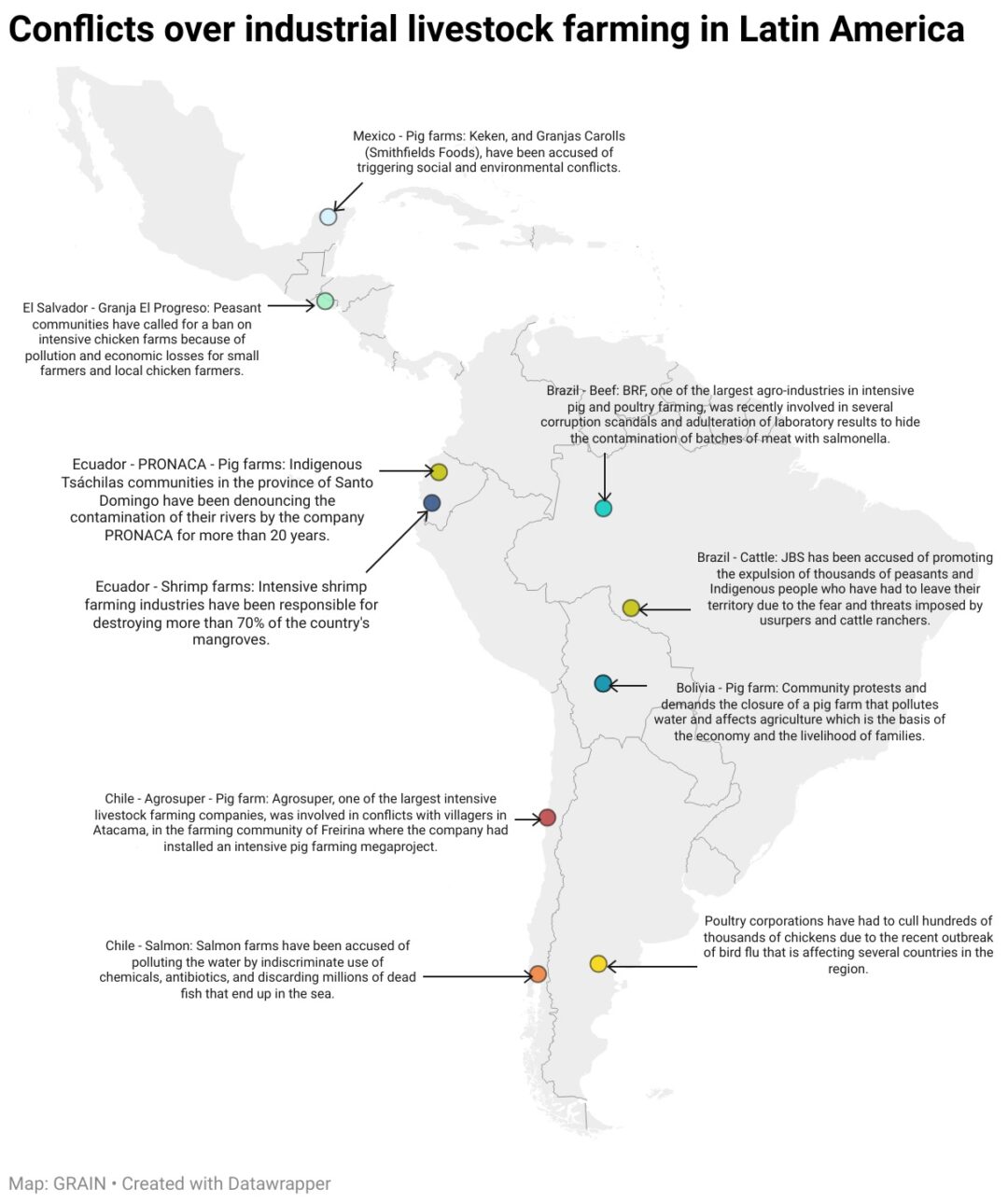


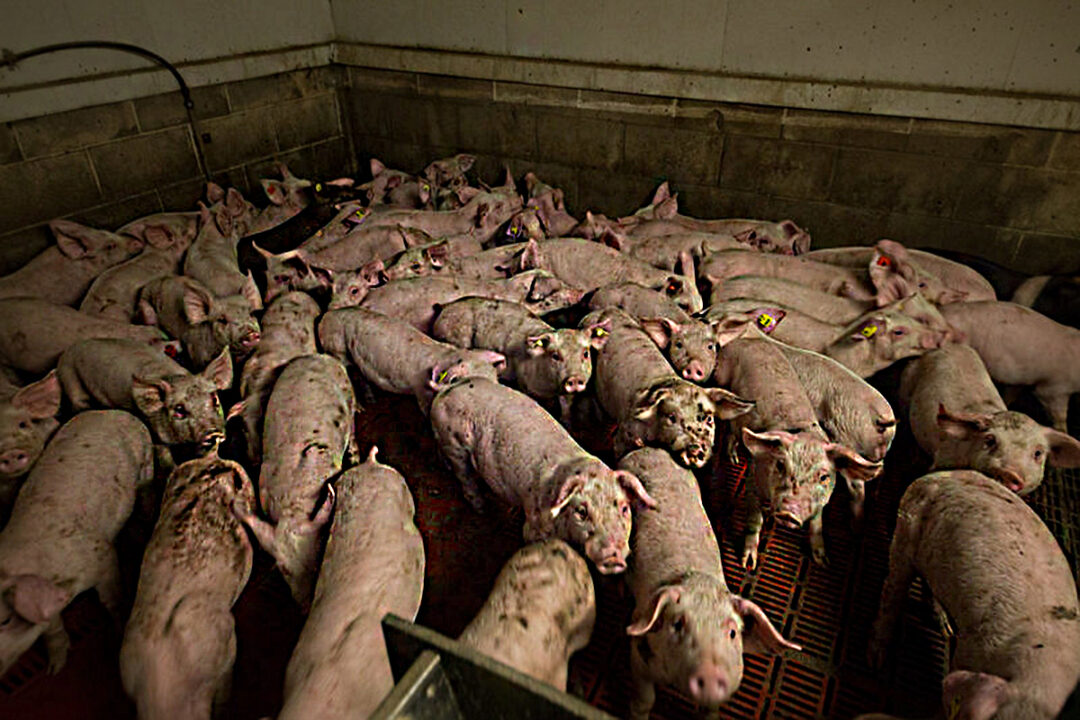
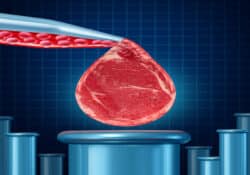
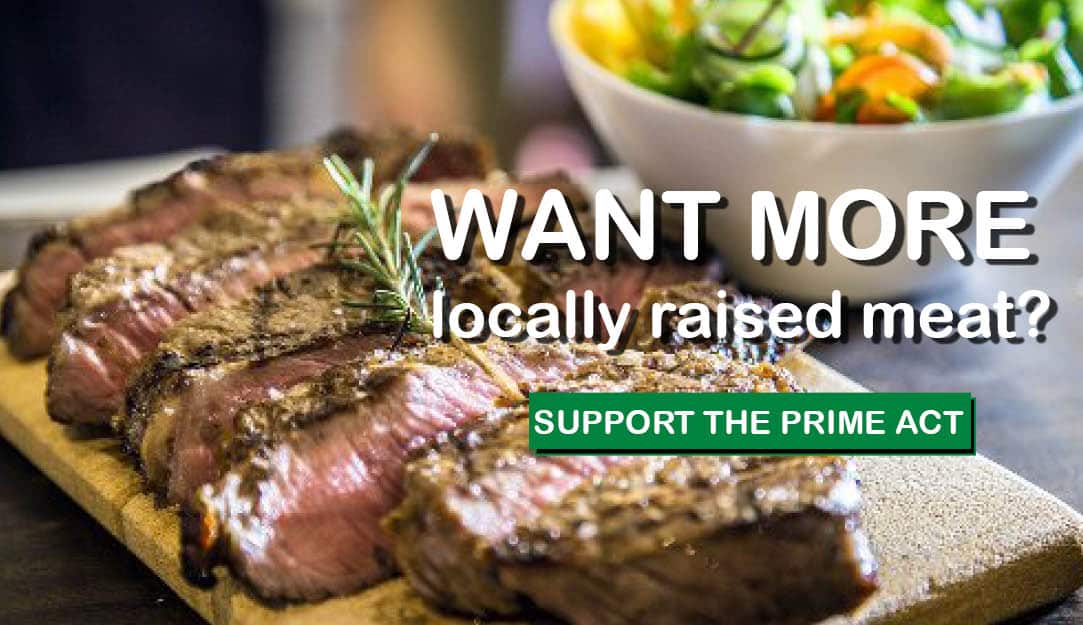
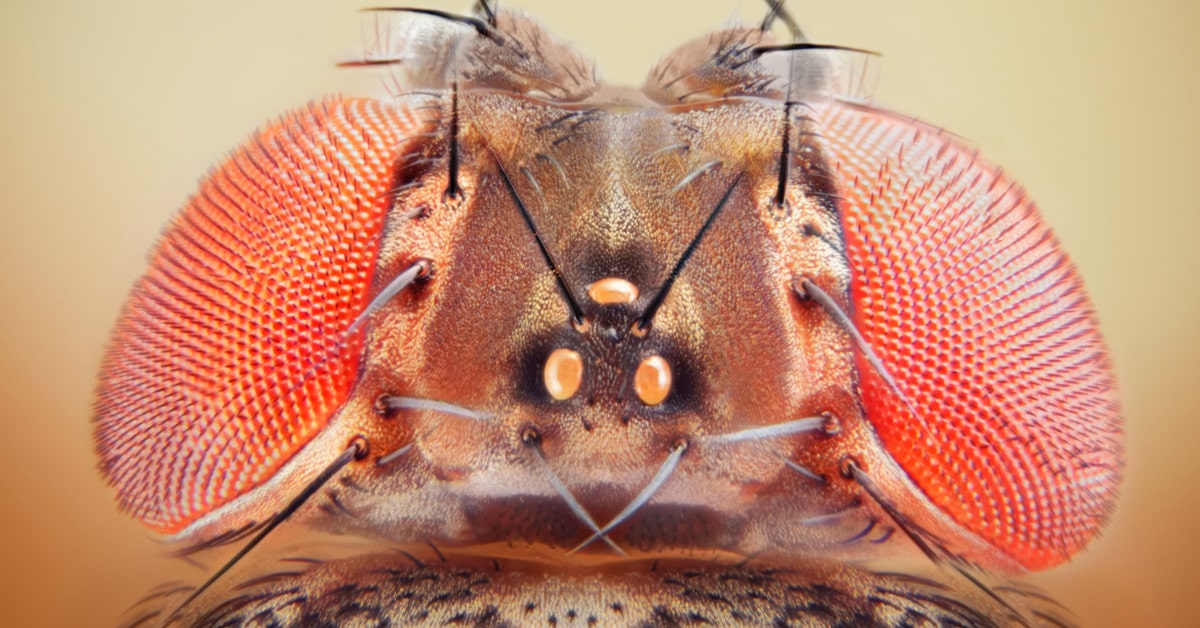

0 Comments